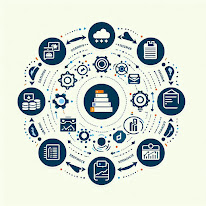
1. Plan
Key Considerations:
> Objectives: What do you hope to achieve with the data?
> Data Sources: Where will the data come from?
> Compliance: Are there regulations (like GDPR) that need
to be adhered to?
2. Capture
Once the planning phase is complete, the next step is to capture the data. This stage encompasses the processes involved in gathering data from various sources. Data can be captured through surveys, sensors, transactions, social media, and other means. The accuracy and reliability of the captured data are vital, as they directly affect the insights drawn later in the life cycle.
Techniques for Data
Capture:
> Surveys and Questionnaires: Collecting qualitative and
quantitative data.
> Automated Data Collection: Using software and tools to
gather data from various sources.
> APIs and Integrations: Capturing data from other
systems in real>time.
3. Manage
Data management refers to the practices and processes employed to store, organize, and maintain data. This stage is crucial for ensuring data quality, security, and accessibility. Effective data management involves using databases, data warehouses, and cloud storage solutions to keep data organized and easily retrievable.
Best Practices for
Data Management:
> Data Quality Control: Regularly validating and cleaning
data to remove inaccuracies.
> Access Control: Implementing permissions to restrict
data access to authorized users.
> Data Backup: Regularly creating backups to prevent data
loss.
4. Analyze
Once data is captured and managed, the next step is analysis. This stage involves examining the data to extract valuable insights that can inform decision>making. Data analysis can take many forms, from simple statistical analysis to advanced techniques like machine learning and predictive analytics.
Methods of Data
Analysis:
> Descriptive Analytics: Summarizing past data to
understand trends.
> Diagnostic Analytics: Identifying the causes of past
events.
> Predictive Analytics: Forecasting future outcomes based on historical data.
5. Archive
After data has served its purpose, it may not need to be accessed frequently but still needs to be retained for compliance, historical analysis, or future reference. Archiving involves transferring data that is no longer actively used into long>term storage solutions. Proper archiving ensures that data remains accessible while freeing up resources for active data management.
Strategies for Effective
Archiving:
> Data Classification: Categorizing data to determine
retention needs.
> Long>Term Storage Solutions: Utilizing cloud storage
or physical media designed for long>term data retention.
> Regular Audits: Periodically reviewing archived data to
ensure it remains relevant and compliant.
6. Destroy
The final stage in the data life cycle is destruction. Once data is no longer needed and its retention period has expired, it should be securely destroyed to prevent unauthorized access or breaches. This stage is critical for protecting sensitive information and ensuring compliance with regulations.
Methods of Data
Destruction:
> Physical Destruction: Shredding physical media or hard
drives.
> Data Wiping: Overwriting digital data to make it
irretrievable.
> Compliance: Ensuring that destruction methods comply
with legal and regulatory standards.
archiving, and ultimately destroying is essential for anyone looking to leverage data effectively. Each stage plays a vital role in ensuring that data remains a valuable asset rather than a liability. By following best practices in each phase, organizations can maximize their data’s potential while minimizing risks. As data continues to grow in importance, mastering its life cycle will be key to thriving in a data driven world.
By following these stages and implementing robust data
management strategies, individuals and organizations can ensure that they not
only protect their data but also use it to make informed decisions that drive
success.

Comments
Post a Comment